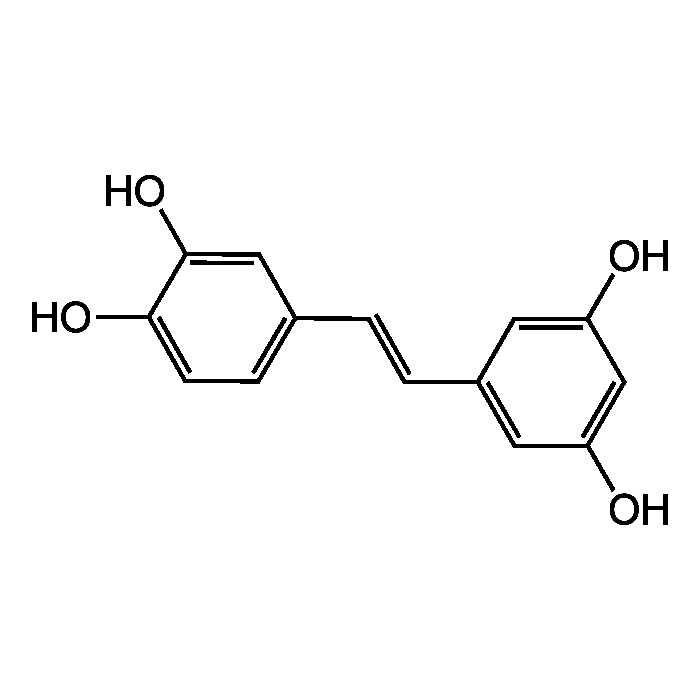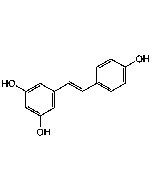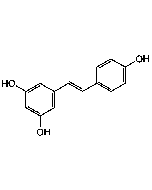Cookie Policy: This site uses cookies to improve your experience. You can find out more about our use of cookies in our Privacy Policy. By continuing to browse this site you agree to our use of cookies.
AdipoGen Life Sciences
Piceatannol
As low as
35
CHF
CHF 35.00
In stock
Only %1 left
AG-CN2-0086-M0011 mgCHF 35.00
AG-CN2-0086-M0055 mgCHF 60.00
AG-CN2-0086-M02525 mgCHF 190.00

| Product Details | |
|---|---|
| Synonyms | CCRIS 9289; NSC365798; NSC622471; 3,3',4,5'-Tetrahydroxy-trans-stilbene; 3-Hydroxyresveratrol |
| Product Type | Chemical |
| Properties | |
| Formula |
C14H12O4 |
| MW | 244.3 |
| CAS | 10083-24-6 |
| Source/Host Chemicals | Synthetic. Originally isolated from Euphorbia lagascae. |
| Purity Chemicals | ≥98% (HPLC) |
| Appearance | Off-white to light pink crystalline solid. |
| Solubility | Soluble in DMSO, dimethyl formamide, ethanol, methanol, acetone or ethyl acetate. Slightly soluble in water. |
| InChi Key | CDRPUGZCRXZLFL-OWOJBTEDBC |
| Smiles | OC1=CC(\C=C\C2=CC=C(O)C(O)=C2)=CC(O)=C1 |
| Shipping and Handling | |
| Shipping | AMBIENT |
| Short Term Storage | +4°C |
| Long Term Storage | +4°C |
| Handling Advice | Protect from light and moisture. |
| Use/Stability | Stable for at least 2 years after receipt when stored at +4°C. |
| Documents | |
| MSDS |
 Download PDF Download PDF |
| Product Specification Sheet | |
| Datasheet |
 Download PDF Download PDF |
Description
- Wide range of tyrosine and serine/threonine protein kinase inhibitor, including Syk, p56lck, PKA, PKC, MLCK, CDPK, JNK and PI3K [1-3, 9, 14, 15].
- Inhibits the tyrosine phosphorylation of STAT3 and STAT5 [4].
- Potent apoptosis inducer [5].
- Potent anticancer compound [6, 10, 16, 17].
- Suppresses NF-kB activation through IkBα kinase inhibition [7].
- Activator of human deacetylase SIRT1 (sirtuin 1) [8].
- Potent antioxidant with anti-proliferative, anti-inflammatory and cardioprotective properties [10, 14, 15, 17, 19].
- Neuoprotective [11, 14].
- Adipogenesis inhibitor [18].
- Promotes glucose uptake, AMPK phosphorylation and GLUT4 translocation [20].
- Autophagy inducer [21]
Product References
- Piceatannol (3,4,3',5'-tetrahydroxy-trans-stilbene) is a naturally occurring protein-tyrosine kinase inhibitor: R.L. Geahlen, et al.; BBRC 165, 241 (1989)
- Inhibition of mast cell Fc epsilon R1-mediated signaling and effector function by the Syk-selective inhibitor, piceatannol: J.M. Oliver, et al.; J. Biol. Chem. 269, 29697 (1994)
- Inhibition of eukaryote serine/threonine-specific protein kinases by piceatannol: B.H. Wang, et al.; Planta Med. 64, 195 (1998)
- Distinct mechanisms of STAT phosphorylation via the interferon-alpha/beta receptor. Selective inhibition of STAT3 and STAT5 by piceatannol: L. Su & M. David; J. Biol. Chem. 275, 12661 (2000)
- Piceatannol, a hydroxylated analog of the chemopreventive agent resveratrol, is a potent inducer of apoptosis in the lymphoma cell line BJAB and in primary, leukemic lymphoblasts: T. Wieder, et al.; Leukemia 15, 1735 (2001)
- Piceatannol, a natural analog of resveratrol, inhibits progression through the S phase of the cell cycle in colorectal cancer cell lines: F. Wolter, et al.; J. Nutr. 132, 298 (2002)
- Piceatannol inhibits TNF-induced NF-kappaB activation and NF-kappaB-mediated gene expression through suppression of IkappaBalpha kinase and p65 phosphorylation: K. Ashikawa, et al.; J. Immunol. 169, 6490 (2002)
- Small molecule activators of sirtuins extend Saccharomyces cerevisiae lifespan: K.T. Howitz, et al.; Nature 425, 191 (2003)
- Piceatannol upregulates endothelial heme oxygenase-1 expression via novel protein kinase C and tyrosine kinase pathways: B.S. Wung, et al.; Pharmacol. Res. 53, 113 (2006)
- Antioxidant activity of resveratrol, piceatannol and 3,3',4,4',5,5'-hexahydroxy-trans-stilbene in three leukemia cell lines: Z. Ovesna, et al.; Oncol. Rep. 16, 617 (2006)
- Protective effects of piceatannol against beta-amyloid-induced neuronal cell death: H.J. Kim, et al.; Ann. N Y Acad. Sci. 1095, 473 (2007)
- Piceatannol inhibits melanogenesis by its antioxidative actions: T. Yokozawa & Y.J. Kim; Biol. Pharm. Bull. 30, 2007 (2007)
- Induction of apoptosis by piceatannol in human leukemic U937 cells through down-regulation of Bcl-2 and activation of caspases: Y.H. Kim, et al.; Oncol. Rep. 19, 961 (2008)
- Piceatannol attenuates 4-hydroxynonenal-induced apoptosis of PC12 cells by blocking activation of c-Jun N-terminal kinase: Y.J. Jang, et al.; Ann. N Y Acad. Sci. 1171, 176 (2009)
- Phosphoinositide 3-kinase is a novel target of piceatannol for inhibiting PDGF-BB-induced proliferation and migration in human aortic smooth muscle cells: K.H. Choi, et al.; Cardiovasc. Res. 85, 836 (2010)
- Piceatannol inhibits migration and invasion of prostate cancer cells: possible mediation by decreased interleukin-6 signaling: G.T. Kwon, et al.; J. Nutr. Biochem. 23, 228 (2012)
- Biological activity of piceatannol: leaving the shadow of resveratrol: H. Piotrowska, et al.; Mutat. Res. 750, 60 (2012) (Review)
- Piceatannol, natural polyphenolic stilbene, inhibits adipogenesis via modulation of mitotic clonal expansion and insulin receptor-dependent insulin signaling in early phase of differentiation: J.Y. Kwon, et al.; J. Biol. Chem. 287, 11566 (2012)
- Antiproliferative and anti-invasive effect of piceatannol, a polyphenol present in grapes and wine, against hepatoma AH109A cells: Y. Kita, et al.; J. Biomed. Biotechnol. 2012, 672416 (2012)
- Piceatannol, a resveratrol derivative, promotes glucose uptake through glucose transporter 4 translocation to plasma membrane in L6 myocytes and suppresses blood glucose levels in type 2 diabetic model db/db mice: M. Minakawa, et al.; BBRC 422, 469 (2012)
- Pro-autophagic polyphenols reduce the acetylation of cytoplasmic proteins: F. Pietrocola, et al.; Cell Cycle 11, 3851 (2012)







